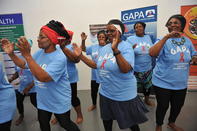The sad reality of being a rape survivor is daunting, as one goes through an extreme physical and emotional trauma. One of the many concerns is the possibility of having contracted HIV. AZT (Zidovudine) is taken as a precautionary measure and although it can make the survivor severely ill, it is a lifeline that many reach to.

Fight Against Disease
When a woman is raped, she goes through a "near death" experience and is left feeling shattered. Her body has been violated, often by several men. In many cases she has been stabbed, beaten or has internal injuries. But somehow, in a state of shock, she must rush to hospital.
There, the second battle begins — a fight not against her rapist, but against disease. For the best chance to avoid HIV, the woman must begin taking antiretroviral drugs within four hours, and for a very good chance within 24 hours. The AZT makes her feel constantly nauseous and exhausted.
A barrage of other tablets, with side-effects including nausea, must also be taken. There is the morning-after pill, taken twice to prevent pregnancies and a week's supply of antibiotics to prevent the sexually transmitted diseases gonorrhoea, chlamydia and trichomonas.
The risk of acquiring HIV from a rape in South Africa is assumed to be high, because many rapes are violent. Sometimes women are gang-raped and as there is a relatively high HIV-prevalence rate, which can be assumed to be even greater amongst rapists, a woman’s risk increases significantly.
